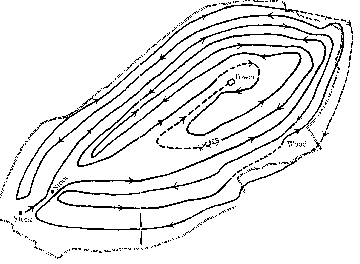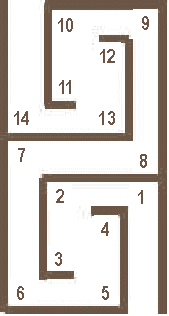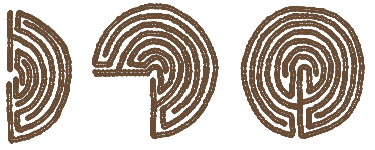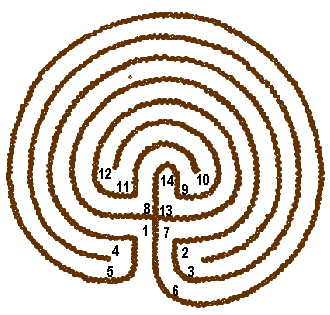|
Over the years, and as an informal community has formed around the Murray Creek Labyrinth,
Native American spirituality and Christian mysticism have found a common
ground on which to develop side by side. The mysticism of Native American
spirituality is one that knows the divine as the Great Spirit
pervading all of
creation. The concept of the Creator as inspiriting creation is a
spirituality
that also informs my own Franciscan path of in-Christ nature mysticism, and
which is similarly compatible with Bob's shamanic
studies and practices. Whereas for a time it seemed we were on different
paths, the convergence of these paths is increasingly apparent.
Obviously there was something about
Murray Creek that attracted us to it. Most apparent was its secluded, quiet beauty.
Beyond that was the magnetism of the creek that flowed through this narrow
mountain valley in the heart of the California Mother Lode. Steep slopes
covered with oaks, pines, manzanita and toyon added yet another dimension to
the mystique of the place. Yet just beneath the surface of so soul-satisfying
a place, there was a brooding something. This we would come to recognize as
the haunting imprint of the past when, a century and a half
before, the dreamtime existence of the tribal people know as the Miwoks had been forever shattered.
In discovering the past of this place we
would be left to ask: How could a supposedly “civilized” people dispossess a
peace-loving people of their lives and the land they loved and honored? And
now, with the many signs of Western Civilization's decline, the effect of
the loss of a way of life that worked should be a concern of all. What, in fact, was lost to the
earth itself when those who had understood how to live upon a land in a
balanced harmonious relationship were no longer here? Gone with the Miwok culture
was
its attunement to the rhythms of nature. And who would deny this as
something sorely needed today?
With “gold fever” spreading out-of-control, the Miwok paradise of peace and harmony was replaced by one form or another of
greed. And so there occurred a rupture of the very fabric of the
psychic environment of this and other places to which the epidemic spread.
When, in 1974, we purchased our sixty-acre parcel, we had
no idea of the transformational work we were agreeing to take on—if, that
is, our lives were not to fall victim, as had others’ before us, to the
distortion of the reality that had caused the disenchantment of this valley.
At the time Bob was still a practicing attorney in the
central valley town of Lodi, some forty miles from here. For a number of
years, a group of like-minded seekers had been meeting in our home every
Friday night. Eventually, three other couples from this group would purchase
and settle on property adjoining ours, but in the early years of our being
here, our Friday night gatherings gradually shifted to monthly Saturday
Quiet Days.
In the beginning, and as we researched the history this
place, a continuing pattern of hostility between the valley’s land owners became apparent.
Could the suffering inflicted on
the Miwoks during the mid 1800’s be a haunting influence over those now
living here? In the early and mid twentieth century the
valley’s history revealed several land “swindles” and numerous boundary and
road disputes, sometimes as malicious as dynamiting the road to block
neighbors’ passage and even the destruction by one neighbor of another’s
spring and water pipeline. Moreover, the very house in which we now live had
been the scene of a suicide.
Early on it became apparent that our being here would have
to be premised on a sense of responsibility for consciously choosing not to
fall into the valley’s entrenched patterns of tragedy and hostility, the
latest having been an actual lawsuit between neighbors just prior to our
purchase. The suit had been over the right-of-way of the road. As a result
of the disillusionment brought on by the lawsuit, most of the property along the road had changed owners. In a way,
this offered a fresh start for the valley, but unfortunately the imprint of
hostility seemed to have remained and to have had a will of its own.
It was soon, very soon after coming here, that we became
aware of the anguish the Miwok's had suffered, and could name it as
"unresolved grief," and sense this as still lingering in the very atmosphere
of the valley.
Perhaps because in coming here our conscious intent had
been to establish a geographical spiritual community, we were more open than
others to a palpable sense of the valley’s need for deep cleansing. Although
this had seemed apparent to us, and others had taken our word for it, we had
no experience in dealing with unresolved grief on a collective level of the
enormity felt to exist here.
In reality, knowledge of how to work with the laws of
spirit that govern a geographic area was something about which tribal
peoples have known considerably more than those of us from Western European
backgrounds. Coincidental to those early years at Murray Creek, Bob was
engaged in an intensive shamanic training program. From this he understood
the necessity of someone consciously embracing the wrong done the Miwoks. It
therefore seemed perfectly appropriate for us to accept this role. After all,
we both were, through heredity, members of the blameworthy race. And we also
were firm believers in the transforming power of prayer and conscious
intent. We were also fortunate in being able to enlist the help of others
with similar beliefs. One thing was clear; in order to intercede for the
forgiveness of the offenders and release for those so willfully
offended, as many of us as possible would need to serve as proxies in
seeking Miwok forgiveness for the genocide committed here. Beyond that, we
would need to pray in some effective way for the lifting and the healing
of the Miwoks’ unresolved grief. As to where to begin and how to proceed,
guidance came in more than one way and through a number of synchronistic
occurrences.
The Re-Enchantment
Process Begins
Sometimes a shaman, after addressing the specifics of a
problem of psychic contamination, and in order to restore the natural
harmony and balance of a place, will find it necessary to “re-enchant” it.
Something along this line is what we set out to do in exercising a group
vocal process called “toning.” Several of us had read Laurel Elizabeth Keyes
book titled Toning, The Creative Power of the Voice. In our first attempt we went
as a group
to an area of the creek where there still existed a large grinding rock.
Here it
was easy to visualize Miwok women crushing and washing away the
bitterness of the acorns that they would then dry and grind into flour. As
we joined our voices and let tones arise from whatever depths we were tapped
into, it so happened that our vocal chords became the instruments through
which the grief of the Miwoks found expression. When this had run its
course, the tones lightened, lifted and attained heights of sound and
harmony beyond our normal individual ranges and ability. Among us was a
sense that release and healing had taken place. There would, however, be more.
Generally, this work of “re-enchanting” our valley has
taken place over a number of years as the need and nature of more healing
work has become apparent. Consistently, what has alerted us to still another
phase of the process has been another outbreak of hostility, often triggered
by something to do with the road or property lines--neither of which were
ever problems for the Miwoks who viewed all land as belonging to the Great
Spirit who had entrusted them with its care, and who in turn they trusted to provide for their needs.
As subsequent hostility has threatened the peace of our valley,
we have taken it as a sign that more work was necessary. As if to guarantee
the work would continue, one particular neighbor has repeatedly
stirred the pot. “Every fool is a tool” is a saying our daughter Louisa
learned from her old-country father-in-law. And except for this neighbor our
labyrinth might never have been created.
The Glastonbury Tor
Labyrinth
Moving on in time, in the spring of 1988 Bob and I made a
trip to Southern England where we visited Glastonbury, lured there by an
abundance of pre
and early Christian lore associated with Glastonbury. The main landscape attraction of the area
is the Tor which is visible for miles around. If you have read The Mists
of Avalon, as had we before going to Glastonbury, you will recall
mention of an unusual bookstore there. At the bookstore we discovered a
pamphlet which compared the pathways winding to the top of the Tor as
approximating the circuitous paths of a labyrinth, and with St Michael's Tower at the top
corresponding the the center of a labyrinth. Following the map
provided in a book titled The Glastonbury Tor Maze by Geoffrey Ashe, (Figure 5)
we followed as best we could the trails to the top, but which at times were
difficult to distinguish from the sheep trails also winding the mountain.
Nevertheless, make it to the top we did, and from which we were
adequately rewarded by the overview of the countryside.

The Tor as Labyrinth
Figure 5
Next we went to London, and down the street from the
British Museum discovered another fascinating bookstore. “Have you anything
on Labyrinths?” we asked. Remember now that this was in 1988 and before the
dozens of books on the subject had been published, even before very many
people were familiar with the word. Nevertheless, the bookstore owner
excused himself for a moment, went to the back of the shop, and emerged with
a 39 page pamphlet by Nigel Pennick titled Labyrinths—Their Geomancy and
Symbolism. The inside cover carried a 1986 copyright. Near the back were
two pages about the Ojai Labyrinth. And among the pictures were ones of Jill Purce and Rupert Sheldrake.
It was one of those “it’s a small world
experiences” because only a short time before Bob and I and several friends
had attended a workshop led by Jill on “Overtone Chanting.” Moreover, we
were familiar and fascinated with Rupert Sheldrake’s theory of morphogenic
resonance, and had found his ideas to have everything to do with the
re-enchanting of the Murray Creek Valley. Bob and our friends, but not I,
proved quick-studies of the method Jill had learned in Tibet and was now teaching. Understandably,
our interests in labyrinths intensified through the synchronicity of the
timing of so many "coincidences."
What Set our
Labyrinth Building Wheels in Motion
No sooner had we returned from England than we discovered
a very large oak had fallen in the meadow at the west end of our property.
Bob set about trimming away the smaller branches and limbs in preparation
for
cutting up the tree and cleaning up the debris so large a fallen tree
leaves. A few days into the job he came back to the house to report
“someone” had nailed a sign to the tree that said “Keep off.” The who was
fairly obvious but the why puzzling. When Bob called, the neighbor insisted the tree
base was on his property. “No way,” Bob said, “it’s fifty feet from your line.
Come down and I’ll show you the corner marker.” “The marker’s been moved,”
the neighbor unreasonably held. We were therefore left with the
necessity of getting the surveyor out to verify the marker was where he had
put it and that it had not been moved.
But was there another why? For what reason was our attention being called to
this spot? In search of understanding, I took the matter under contemplation.
Was it simply more of the same old residue of hostility resurfacing in the
valley once again?. Whereas previously our focus
had been on the Miwoks and the past, it seemed now to be a problem of
present antagonism looking for an excuse to express itself. If so, then clearly
some creative way of defusing the situation was called for. Otherwise, whereas it was
a tree this time it would be something else next time, and whenever an
excuse for aggravation presented itself. What was needed and what I was
asking for was a means by which the loss of a giant oak could be used for
the further healing of
our valley. When I was able to clarify and ask the question, the immediate response was: “Build a
labyrinth where the tree fell.”
Somewhat flabbergasted by so quick, direct
and simple an answer, I went into listening mode for something further by
way of explanation. What came were the words: sacrifice and ritual.
From these two words, I understood that the building of a labyrinth would be a sacrifice of energy and
that walking a
labyrinth was an ancient form of ritual. Further, it was one the Miwoks could appreciate and to
which they would lend their energy. I received this to mean that forgiveness
and reconciliation with the Miwoks had happened and that they were now to be
willing participants in the re-enchanting of their homeland. I received all
this on faith and began casually mentioning to
friends and neighbors the idea of building our own Murray Creek Labyrinth.
Our neighbor Jim Naylor was so receptive to the idea that he immediately
began gathering pickup loads of rock.
The Year the Creek Ran Dry
For most of the summers we had been here water had continued to
flow through Murray Creek. But then had come several drought years in a row
and in the summer of 1988 the creek run dry. A standing joke had been that no
matter how many rocks were taken out of the creek, more grew in their place.
But at no time had it been easier to harvest the creek's rock crop than the
summer and fall of 1988 when it was possible to drive right down
into the bed of the creek. By the first weekend in
November Jim and his pickup had dumped twenty-four loads around the
area marked off for the labyrinth in the exact place where the
big oak had fallen. Also interesting is the fact that on our entire sixty acres
this is the only area both flat and large enough to build a stone labyrinth
after the classical pattern for which we had directions
and in which persons coming in and going out could pass. Was all this
coincidence or was it synchronistic? When an archetype is stirring to life,
are heaven and earth moved to help?
Our design for the labyrinth required a
very large stone--a "Mother Stone," and which was located in the now-dry
creek directly adjacent to the labyrinth site. Once its right placement had
been dowsed, it was a simple matter for our neighbor Sam Jones to secure it
to his truck equipped with a winch, and drag it into place.
I hope it is apparent by now that Bob and I had very
little to do with making the Murray Creek Labyrinth happen. Rather it was
the result of a contagious idea that became a group vision and to which some
twenty persons gave their enthusiasm and energy.
Polly Naylor’s good friend Marsha came to help and brought
along her video camera to capture the event. Our friend Dan Stephens edited
it down to twenty-minutes of highlights, and from these made the stills
shown in Part III.
|





